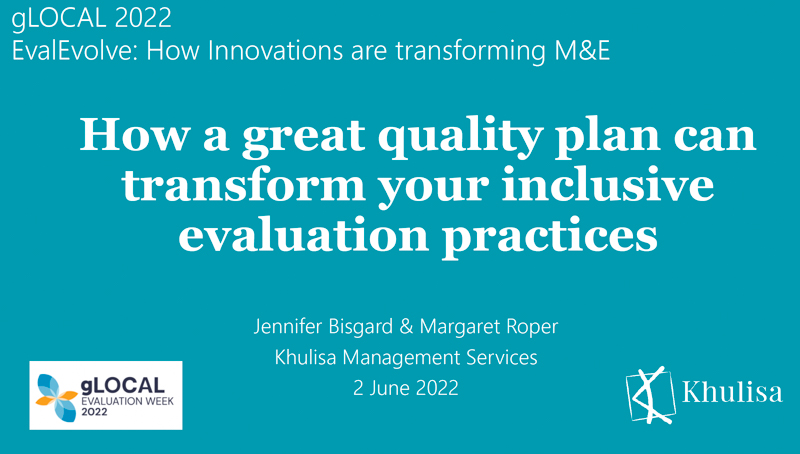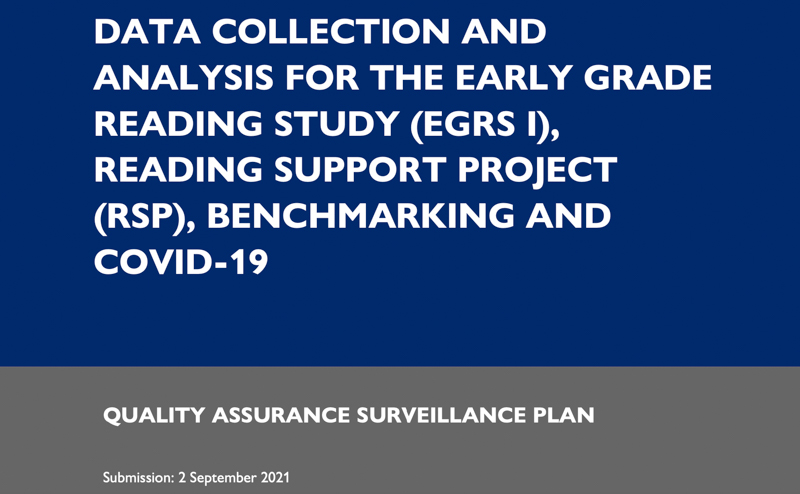By Jennifer Bisgard and Margie Roper
During the recent gLOCAL 2022 Evaluation Week, Khulisa hosted a webinar on “How a Great Quality Assurance Plan Can Transform Your Inclusive Evaluation Practices”.

The webinar focused on why a quality assurance surveillance plan (QASP) is important for every evaluation, the importance of inclusion of stakeholders and beneficiaries, and how to create and execute a QASP. We hope you’ll watch the entire webinar on Khulisa’s YouTube channel. But if you don’t have time for that, here is a quick summary of our presentation. You can also download the slides.
Quality is essential to every evaluation; there’s no point conducting an evaluation that no one is going to use. And we all know data quality is one of the most important aspects of an evaluation. Quality data improves results, decreases project risks, and increases better decision-making.
But quality assurance is about more than just collecting good data: it’s about implementing and maintaining excellence throughout every stage of the evaluation process.
What is a QASP?
A QASP is a written plan, created before an evaluation begins, which clearly lays out project roles, timelines, ethical guidelines, quality standards, potential challenges and solutions, and any other items that will ensure excellence over the course of an evaluation.
A good QASP is much more than a checklist – the QASP should guide quality across every element and stage of an evaluation, ensuring that the evaluation results are useful, actionable, and inclusive of all stakeholders involved. QASPs help clarify and manage the client’s expectations, protect data privacy and confidentiality, and identify potential risks and vital course corrections during an evaluation.
In our webinar, we shared an example of a QASP Khulisa recently implemented as part of a USAID-funded evaluation of early grade reading programs in South Africa.

This project was a multi-million-dollar evaluation, with thousands of learner assessments by more than 150 fieldworkers in 260 schools. Our QASP for this evaluation was more than 20 pages long and extremely detailed, but served as an essential tool in completing this evaluation during the Covid-19 pandemic and resultant lockdowns. The QASP allowed us to have a master document that mapped out both the evaluation process and the quality process during this large, complex, and multifaceted study.
We also shared a simplified QASP template during the webinar, which participants can customize to create their own QASP. Smaller evalutions can include shorter QASPs.
Tips for Creating a Great Quality Plan
Our webinar includes several tips for creating a QASP that will enhance inclusive evaluation practices. A few of those tips are below; please check out the webinar for more tips and explanations:
· Always consult your original proposal as a guideline for writing the QASP.
· The QASP should be designed to go hand-in-hand with the evaluation’s Fieldwork Manual.
· Include stakeholders and seek their feedback across all the QASP elements.
· Set clear inclusion and exclusion criteria for participation in or out of the evaluation.
· Use the QASP as a reminder to pre-test all evaluation tools and gain the perspective of evaluation beneficiaries.
· Include data privacy and protection protocols and ethics processes in quality standards.
In the coming weeks, we’ll also be creating a series of #EvalTuesdayTips about creating a great QASP.